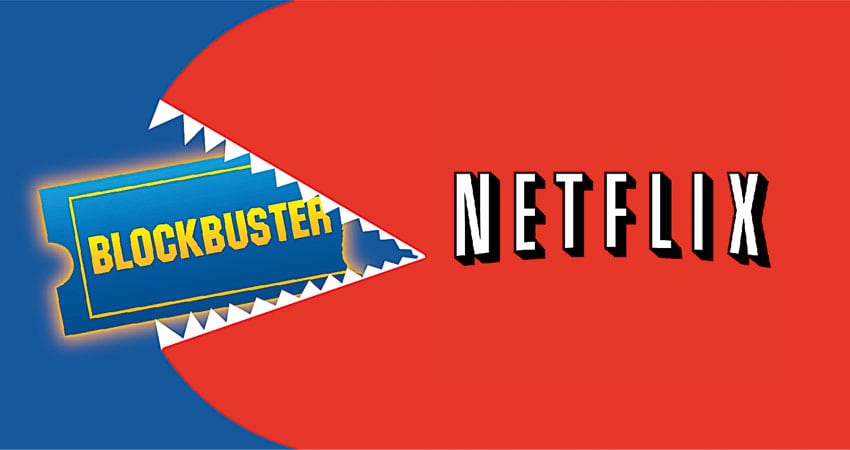Early May was a bloodbath for retail stocks as Wall Street reacted negatively to disappointing quarterly earnings from Macy’s, Kohl’s, Nordstrom, J.C. Penney and Sears. These companies and other retailers have fallen far from their prime largely due to the changing behavior of consumers and market dominance of Amazon, which logged 53% of online sales growth in the U.S. in 2016 according to data from Slice Intelligence.
The way retail incumbents can (or should) deal with Amazon’s industry-leading innovation is analogous to the Blockbuster-Netflix saga a decade ago. For those who remember, Blockbuster was the leading movie rental business but it struggled to compete with small, crafty upstart Netflix. The latter used non-traditional distribution enabled by new technology to chip away at Blockbuster’s non-technical and soon-to-be outdated business model.
Not unlike today’s retail giants, Blockbuster started with a valuable consumer proposition, growing from its first store in 1985 to ~ 9,000 stores a decade later. At its peak, there was a Blockbuster on virtually every retail corner in the United States and the company boasted a $5 billion market capitalization. The business model had its faults – it required a drive to the store and penalized consumers with annoying but profitable late fees. Netflix exploited these weaknesses with a distribution model that required no store visit and a business model that depended on a monthly subscription fee versus those bothersome late penalties.
Blockbuster should have embraced the change, bringing together the best of its retail footprint with a Netflix-like delivery model. Instead, it doubled-down on its core bricks-and-mortar business, ignoring emerging consumer trends, famously turning down the opportunity to purchase Netflix for $50M, and instead acquired video store chain Hollywood Video. Just a few years later, Blockbuster went out of business. Today, Netflix is thriving and boasts a market capitalization in excess of $70 billion. But it’s worth noting that even Netflix had to pivot from its initial model that trumped Blockbuster to online streaming and original content.
Now is a particularly good time for retailers to learn from Blockbuster’s mistakes and aggressively acquire smaller, well-positioned ecommerce companies. The best management teams can still course-correct through ambitious acquisitions of innovative startups and business models, learning lessons from past incumbents in other industries that faced changing technologies and consumer realities. As Blockbuster could have leveraged its retail footprint to enhance a Netflix-like offering, so too can existing retailers leverage their scale, supply chain, and distribution advantages in concert with innovative startup aggressors.
Beyond the strategic imperative, incumbents presently face rewarding market conditions when making acquisitions. They have market capitalizations sufficient to buy smaller startups and, as highlighted by Fortune’s Erin Griffith, Wall Street has been more forgiving of companies—particularly retailers—making acquisitions than in the past.
This is likely the reason that Walmart, which recently has been aggressively acquiring tech-enabled ecommerce companies and brands, avoided the earnings bloodbath and is the only major retailer on the list below to show stock price appreciation over the last decade or so, other than Amazon:
| RETAILER | MARKET VALUE 2006 | MARKET VALUE TODAY | % CHANGE |
| SEARS | $27.8B | $831.7M | -97% |
| JC PENNEY | $18.1B | $1.15B | -83% |
| KOHL’S | $24.8B | $6.6B | -73% |
| BEST BUY | $28.8B | $15.5B | -46% |
| MACY’S | $24.2B | $6.9B | -71% |
| NORDSTROM | $12.4B | $6.2B | -50% |
| TARGET | $51.3B | $30.4B | -40% |
| WALMART | $214.0B | $230.0B | +7% |
| AMAZON | $17.5B | $464.5B | +2,554% |
The recent earnings news was just the latest evidence of a retail trend that has been playing out for a decade. The retail environment will continue to shift with technology-driven changes that have altered consumer behavior. It’s apparent that slow action by incumbents will result in a missed opportunity to reclaim market share.
By the time Blockbuster realized it could no longer ignore Netflix, the startup had grown too big for them acquire and too powerful for them to beat. Retailers are facing a similar situation now and should not let over reliance on traditional financial analysis cause them to miss their inexpensive “$50M Netflix acquisition.”
My kids use Netflix every day, but have never heard of Blockbuster. It’s in the hands of today’s retail management teams to ensure that the next generation knows the names of today’s largest retail brands.
Tige Savage is co-founder and managing partner of Revolution LLC and co-leads Revolution Ventures
